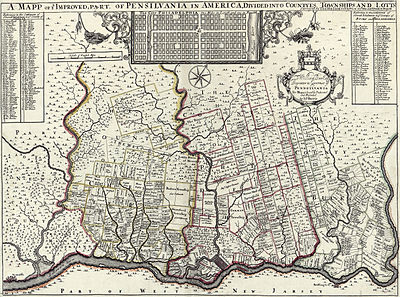Welsh Tract
| Part of a series on |
| European colonization of the Americas |
|---|
 |
|
|
TheWelsh Tract,also called theWelsh Barony,was a portion of theProvince of Pennsylvania,a British colony in North America (today aU.S. state), settled largely byWelsh-speakingQuakersin the late 17th century. The region is located to the west ofPhiladelphia.The original settlers, led by John Roberts, negotiated withWilliam Pennin 1684 to constitute the Tract as a separate county whose local government would use theWelsh language.TheBaronywas never formally created, but the many Welsh settlers gave their communities Welsh names that survive today. A more successful attempt at setting up aGwladfa(Welsh-speaking colony) occurred two centuries later, in theChubut ProvinceofPatagonia,Argentina.
History
[edit]
In the late 17th century, there was significant Welsh immigration to Pennsylvania for religious and cultural reasons. In about 1681, a group of Welsh Quakers met withWilliam Pennto secure a land grant to conduct their affairs in their language. The parties agreed on a tract covering 40,000 acres (160 km2), to be constituted as a separate county whose people and government could conduct their affairs in Welsh.
Whereas divers considerable persons amongÞeWelsh Friends have requested me Þtall ÞeLands Purchased of me by those of North Wales and South Wales, together with Þeadjacent counties to Þm,as Haverfordshire, Shropshire and Cheshire, about 40,000 acres, may be laydout contiguously as one Barony, alledging ÞtÞenumber allready come and suddenly to come, are such as will be capable of planting Þesame much wthin Þeproportion allowed by Þecustom of Þecountry, & so not lye in large useless vacancies. And because I am inclined and determined to agree and favor Þmwthany reasonable Conveniency and priviledge: I do hereby charge thee and strictly require thee to lay out Þesd tract of Land in as uniform a manner as conveniently may be, upon Þewest side of Skoolkill river, running three miles upon Þesame, & two miles backward, & then extend Þeparallel wthÞeriver six miles and to run westwardly so far as this Þesd quantity of land be Compleatly surveyed unto you.—Given at Pennsbury, Þe13th Ist mo. [March] 1684.[1][2]
Whereas diverse considerable persons among the Welsh Friends have requested me that all the Lands Purchased of me by those of North Wales and South Wales, together with the adjacent counties to them, as Herefordshire, Shropshire and Cheshire, about forty-thousand acres, may be laid out contiguously as one Barony, alledging that the number already come and suddenly to come, are such as will be capable of planting the same much within the proportion allowed by the custom of the country, and so not lye in large useless vacancies. And because I am inclined and determined to agree and favor them with any reasonable Conveniency and privilege: I do hereby charge thee and strictly require thee to lay out the said tract of Land in as uniform a manner as conveniently may be, upon the west side of Schuylkill river, running three miles upon the same, and two miles backward, and then extend the parallel with the river six miles and to run westwardly so far as this the said quantity of land be Completely surveyed unto you.
— Given atPennsbury,the 13th Ist mo. [March] 1684.
The Welsh Tract's boundaries were established in 1687, but notwithstanding the prior agreement, by the 1690s the land had already been partitioned among different counties, despite appeals from the Welsh settlers, and the Tract never gained self-government.[3]
The Roberts and other Welsh families became influential in the area, through the building of mills and the eventual introduction of the railroad. It is the railroad that gives the best-known part of the area its current name, thePhiladelphia Main Line,named after themainlineof thePennsylvania Railroad,portions of which were absorbed into Conrail in 1976 (with Amtrak operating intercity passenger rail service from 1971, SEPTA operating commuter rail service from 1983, and Norfolk Southern acquiring Conrail's freight operations in 1997) as one of the principal rail lines running between Chicago, IL and the Eastern seaboard. After theAmerican Civil War,104 Welsh families from this region migrated toKnoxville, Tennessee,establishing a strong Welsh presence there.
As suburbanization spread westward from Philadelphia in the late 19th century (thanks to the railroads), living in a community with a Welsh name acquired a cachet. Some communities in the area formerly comprising the Welsh Tract were subsequently given Welsh or Welsh-sounding names to improve their perceived desirability. Among these wereGladwyne,formerly "Merion Square" (which was given its new name in 1891, although the name is meaningless in Welsh), andBryn Mawr,formerly "Humphreysville" (which was renamed in 1869).
Today
[edit]The area is now part ofMontgomery,Chester,andDelawarecounties. Many towns in the area still bear Welsh names. Some, such asNorth Wales,Lower Gwynedd,Upper Gwynedd,Lower Merion,Upper Merion,Narberth, Bala Cynwyd,Radnor,Berwyn,andHaverford Township,are named after places inWales.Others, such asTredyffrinandUwchlanhave independent Welsh names.
A second "Welsh Tract" of 30,000 acres (120 km2) was granted to Welsh emigrants by William Penn in 1701. It made up the modernPencader Hundred,Delaware, and some ofCecil County, Maryland.[4]
See also
[edit]- Cambria, Pennsylvania
- Churchtown, Pennsylvania,settled by Welsh adherents of theChurch of England
- History of Pennsylvania
- Welsh American
Further reading
[edit]- Corcoran, Irma (1992).Thomas Holme, 1624–1695: Surveyor General of Pennsylvania, Volume 200 of Memoirs of the American Philosophical Society, American Philosophical Society.Diane Publishing. p. 317.ISBN9780871692009.
References
[edit]- ^Thomas Allen Glenn,Merion in the Welsh Tract(Norristown, PA: Herald Press, 1896), pp. 26–27.
- ^Jordan, John Woolf (1914).A History of Delaware County, Pennsylvania, and Its People, Volume 1.Lewis Historical Publishing Company. p. 115.ISBN9785876569028.
- ^Magda, Matthew S.,The Welsh in Pennsylvania,The Peoples of Pennsylvania Pamphlet No. 1, Pennsylvania Historical and Museum Commission, 1998.
- ^"Welsh Tract".archives.delaware.gov.Delaware Public Archives. n.d.RetrievedApril 2,2021.
Northern boundary line of tract of thirty thousand acres granted to Welsh by William Penn, 1701. It included what is now Pencader Hundred, Delaware, and a part of Cecil County, Maryland.
